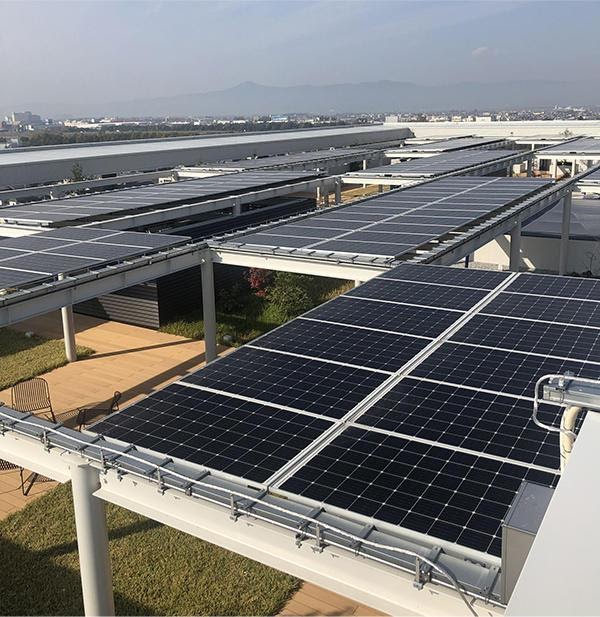OMRON Energy Efficient Building
Information
Reduced annual energy consumption by 50% in the company's new office.
In order to combat global warming and stabilize energy supply and demand, reduction of our energy consumption is necessary. According to the FY2018 Energy Supply and Demand Results (confirmed data report) published by the Agency for Natural Resources and Energy, the corporate and office sector accounts for more than half of Japan's energy consumption, that is about 63%. To reduce the energy consumption of society as a whole, it is important to find ways to save energy in all corporate activities, including offices. This is why ZEB (Net Zero Energy Buildings), which achieve significant energy savings without degrading the quality of the building's indoor and outdoor environment, have been attracting attention. In this article, we will introduce a case study of OMRON Yasu Office Building No.1, which construction was completed in 2019 and has acquired "ZEB Ready" certification.
Reducing the Burden on the Global Environment by Reducing Energy Consumption in Office Buildings
The OMRON Group, based on its corporate philosophy, is working on its "Green OMRON 2020 Environmental Vision" to contribute to the creation of a sustainable society. As part of this initiatives, the new Building 1 in Yasu Office was planned to be designed as earth- and community-friendly, with the goal of obtaining ZEB Ready certification. In this project, the Yasu Office and OMRON SOCIAL SOLUTIONS Co., Ltd.(OSS) worked together to actively promote energy conservation and energy creation by combining a variety of environmentally friendly technologies with OSS products and succeeded in reducing the building's energy consumption by 50%*1. In 2019, we were certified as "ZEB Ready" under the Building Energy Efficiency Labeling System (BELS). The acquisition of this certification is a major first step in our initiativess to reduce the environmental impact of our business activities.
*1 The primary energy consumption standard is calculated by the primary energy consumption per unit area. In this case, the design value is 942/standard value is 1,895, which means that the system is operating at 49.7% of the standard value, resulting in a reduction of 50.3%.
Improving the Energy Balance Through Both Energy Conservation and Energy Creation
"ZEB" refers to a building that has achieved a significant improvement in its energy balance in terms of "energy conservation", such as high thermal insulation and reduced electricity consumption, "energy creation", such as through solar power generation, and "energy storage", such as through fuel cells. The Yasu Office has reduced its total energy consumption through two of these measures; "energy conservation" and "energy creation". The number of employees working in Building 1 is 1,500, and the floor area is 20,052 m2. The building includes a factory, laboratories, offices, and a rooftop green park, making this facility alone as large as a single company. The project team for the new Yasu Office, including the construction company in charge of design and construction, worked together to obtain ZEB Ready certification. In addition, various OMRON sensors as follows are used to promote ZEB.
First, in terms of energy conservation, we have adopted a system that automatically controls lighting and air conditioning according to the number of employees in each area using Human Vision Components, and a system that controls the amount of outside air introduced according to the CO₂ concentration using CO₂ sensors to reduce the power used for air conditioning. Even in a social environment that goes against energy conservation, such as maximizing the amount of ventilation due to the spread of the COVID-19 infection, we are working on energy conservation that does not place a burden on employees while making compromises.
And in terms of energy creation, the OSS has installed solar panels on the rooftop, which are being operated efficiently using the BEMS (Building Energy Management System). The solar panels have a checkerboard pattern etched on their surface, which optimizes the absorption of solar energy and increases power generation efficiency.
The energy created by the solar power generation in the Building No. 1 led to a reduction in electricity purchases equivalent to about 82,000 kWh from April to October in 2020, which is about 140,000 kWh on an annual basis. The Yasu Office has four buildings of factories and offices and together with the existing efforts, the Yasu Office as a whole has achieved a reduction of 2.17 million kWh per year in electricity purchase. This is equivalent to 5% of the total annual electricity purchase of the Yasu Office.

Aiming for the Low-carbon Society Throughout the Entire Group While Promoting Cost Reduction
The Yasu Office Building No. 1 has reduced its annual energy consumption by about half through the implementation of environmental measures. Its annual electricity purchase cost has also been reduced by about 1.5 million yen through the generation of solar panels. The resulting 37% reduction in CO2 emissions is equivalent to the CO2 absorbed by 6,400 poplar trees*2.
OMRON will share the know-how cultivated through this case study with other offices to expand the harmony of energy conservation and energy creation throughout the Group, while promoting even more advanced measures in the future to further reduce energy consumption and costs. In order to realize the low-carbon society that OMRON aims for, we will continue our environmental initiatives for the future and keep aiming for zero greenhouse gas emissions by 2050.
*2 The amount of CO2 absorbed by poplar is calculated as 52 kg-CO2 per year.
Download PDF version here.